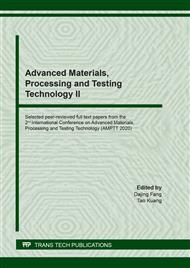[1]
A. Zocca, P. Colombo, C.M. Gomes, Additive manufacturing of ceramics: issues, potentialities, and opportunities, J. Am. Ceram. Soc. 98 (7) (2015) 1983–(2001).
DOI: 10.1111/jace.13700
Google Scholar
[2]
Hu K, Wei Y, Lu Z, et al. Design of a shaping system for stereolithography with high solid loading ceramic suspensions [J]. 3D Printing and Additive Manufacturing, 2018, 5 (4): 311-318.
DOI: 10.1089/3dp.2017.0065
Google Scholar
[3]
Ligon S C, Liska R, Stampfl J, et al. Polymers for 3D printing and customized additive manufacturing [J]. Chemical reviews, 2017, 117 (15): 10212-10290.
DOI: 10.1021/acs.chemrev.7b00074
Google Scholar
[4]
Li X, Hu K, Lu Z. Effect of light attenuation on polymerization of ceramic suspensions for stereolithography [J]. Journal of the European Ceramic Society, (2019).
DOI: 10.1016/j.jeurceramsoc.2019.01.002
Google Scholar
[5]
Shortall A C, Harrington E. Temperature rise during polymerization of light‐activated resin composites [J]. Journal of Oral Rehabilitation, 1998, 25(12): 908-913.
DOI: 10.1046/j.1365-2842.1998.00336.x
Google Scholar
[6]
McCabe J F. Cure performance of light-activated composites by differential thermal analysis (DTA) [J]. Dental Materials, 1985, 1 (6): 231-234.
DOI: 10.1016/s0109-5641(85)80048-8
Google Scholar
[7]
Hansen E K, Asmussen E. Correlation between depth of cure and temperature rise of a light-activated resin [J]. European Journal of Oral Sciences, 1993, 101 (3): 176-181.
DOI: 10.1111/j.1600-0722.1993.tb01659.x
Google Scholar
[8]
Hadjou Belaid Z, Mechernene L, Abdoune F Z, et al. Photo-differential Scanning Calorimetry Study on Photopolymerization of Polyacrylate/E7 Liquid Crystal Blends [J]. Journal of Macromolecular Science, Part B, 2019, 58 (1): 1-15.
DOI: 10.1080/00222348.2018.1452496
Google Scholar
[9]
Dickens S H, Stansbury J W, Choi K M, et al. Photopolymerization kinetics of methacrylate dental resins [J]. Macromolecules, 2003, 36 (16): 6043-6053.
DOI: 10.1021/ma021675k
Google Scholar
[10]
Ghorpade R V, Bhosle S M, Ponrathnam S, et al. Photopolymerization kinetics of 2-phenylethyl (meth) acrylates studied by photo DSC [J]. Journal of Polymer Research, 2012, 19 (2): 9811.
DOI: 10.1007/s10965-011-9811-3
Google Scholar
[11]
Ji L, Chang W, Cui M, et al. Photopolymerization kinetics and volume shrinkage of 1, 6-hexanediol diacrylate at different temperature [J]. Journal of Photochemistry and Photobiology A: Chemistry, 2013, 252: 216-221.
DOI: 10.1016/j.jphotochem.2012.12.010
Google Scholar
[12]
Hideo Takada. Thermodynamics of Polymerization. Yan Haike, Jin Shijiu. Translation: Beijing: Science Press, 1985. 153-197.
Google Scholar
[13]
Randolph L D, Palin W M, Watts D C, et al. The effect of ultra-fast photopolymerisation of experimental composites on shrinkage stress, network formation and pulpal temperature rise [J]. Dental Materials, 2014, 30 (11): 1280-1289.
DOI: 10.1016/j.dental.2014.09.001
Google Scholar
[14]
Burdick J A, Peterson A J, Anseth K S. Conversion and temperature profiles during the photoinitiated polymerization of thick orthopaedic biomaterials [J]. Biomaterials, 2001, 22 (13): 1779-1786.
DOI: 10.1016/s0142-9612(00)00347-1
Google Scholar
[15]
Westbeek S, van Dommelen J A W, Remmers J J C, et al. Multiphysical modeling of the photopolymerization process for additive manufacturing of ceramics [J]. European Journal of Mechanics-A/Solids, 2018, 71: 210-223.
DOI: 10.1016/j.euromechsol.2018.03.020
Google Scholar
[16]
Goodner M D, Bowman C N. Development of a comprehensive free radical photopolymerization model incorporating heat and mass transfer effects in thick films[J]. Chemical Engineering Science, 2002, 57 (5): 887-900.
DOI: 10.1016/s0009-2509(01)00287-1
Google Scholar
[17]
Porko C, Hietala E L. Pulpal temperature change with visible light-curing [J]. Operative dentistry, 2001, 26 (2): 181-185.
Google Scholar
[18]
Uhl A, Mills R W, Jandt K D. Polymerization and light-induced heat of dental composites cured with LED and halogen technology [J]. Biomaterials, 2003, 24 (10): 1809-1820.
DOI: 10.1016/s0142-9612(02)00585-9
Google Scholar
[19]
Cobb D S, Dederich D N, Gardner T V. In vitro temperature change at the dentin/pulpal interface by using conventional visible light versus argon laser [J]. Lasers in Surgery and Medicine: The Official Journal of the American Society for Laser Medicine and Surgery, 2000, 26 (4): 386-397.
DOI: 10.1002/(sici)1096-9101(2000)26:4<386::aid-lsm7>3.0.co;2-c
Google Scholar
[20]
Morel M, Lacoste J, Baba M. Photo-DSC I: A new tool to study the semi-crystalline polymer accelerated photo-ageing [J]. Polymer, 2005, 46 (22): 9274-9282.
DOI: 10.1016/j.polymer.2005.06.116
Google Scholar
[21]
Griffith M L, Halloran J W. Freeform fabrication of ceramics via stereolithography [J]. Journal of the American Ceramic Society, 1996, 79 (10): 2601-2608.
DOI: 10.1111/j.1151-2916.1996.tb09022.x
Google Scholar
[22]
allnex, allnex - Product HDDA,, https://www.allnex.com/cn/product/9351fea1-0383-4674-853e-fbd5e45744b5/hdda-3.
Google Scholar
[23]
DSM, AgiSyn 2844 | Product Finder Details | High-performance coating resins from DSM | paint,,https://www.dsm.com/markets/paint/en/productfinderdetails.DR_DCR_000000000031103.html.
Google Scholar
[24]
Neumann M G, Miranda Jr W G, Schmitt C C, et al. Molar extinction coefficients and the photon absorption efficiency of dental photoinitiators and light curing units [J]. Journal of dentistry, 2005, 33 (6): 525-532.
DOI: 10.1016/j.jdent.2004.11.013
Google Scholar
[25]
Muskin J, Ragusa M, Gelsthorpe T. Three-dimensional printing using a photoinitiated polymer [J]. Journal of Chemical Education, 2010, 87 (5): 512-514.
DOI: 10.1021/ed800170t
Google Scholar
[26]
Bass M, Van Stryland E W, Williams D R. Handbook of optics[M]. New York: McGraw-Hill, (1995).
Google Scholar
[27]
Goodner M D, Bowman C N. Development of a comprehensive free radical photopolymerization model incorporating heat and mass transfer effects in thick films [J]. Chemical Engineering Science, 2002, 57 (5): 887-900.
DOI: 10.1016/s0009-2509(01)00287-1
Google Scholar
[28]
For n-Butyl acrylate: R. M. Joshi, J. Polymer Sci., 56, 313 (1963) and K. G. McCurdy, K. J. Laidler, Can. J. Chem. 42, 818 (1964).
Google Scholar
[29]
Chemeo, Chemical and Physical Property Prediction for Hexamethylene diacrylate', 2016, https://www.chemeo.com/predict,smiles=C%3DCC%28%3DO%29OCCCCCCOC%28%3DO%29C%3DC.
Google Scholar
[30]
Flach L, Chartoff R P. A process model for nonisothermal photopolymerization with a laser light source. I: Basic model development [J]. Polymer Engineering & Science, 1995, 35 (6): 483-492.
DOI: 10.1002/pen.760350605
Google Scholar
[31]
Tang Y, Henderson C L, Muzzy J, et al. Stereolithography cure process modeling using acrylate resin [C] //Solid Freeform Fabrication Symposium. (2004).
Google Scholar
[32]
Karasu F, Aydin M, Kaya M A, et al. Determination of photoinitiated polymerization of multifunctional acrylates with acetic acid derivatives of thioxanthone by RT-FTIR [J]. Progress in Organic Coatings, 2009, 64 (1): 1-4.
DOI: 10.1016/j.porgcoat.2008.07.004
Google Scholar
[33]
Taki K, Watanabe Y, Ito H, et al. Effect of oxygen inhibition on the kinetic constants of the UV-radical photopolymerization of diurethane dimethacrylate/photoinitiator systems [J]. Macromolecules, 2014, 47 (6): 1906-1913.
DOI: 10.1021/ma402437q
Google Scholar


